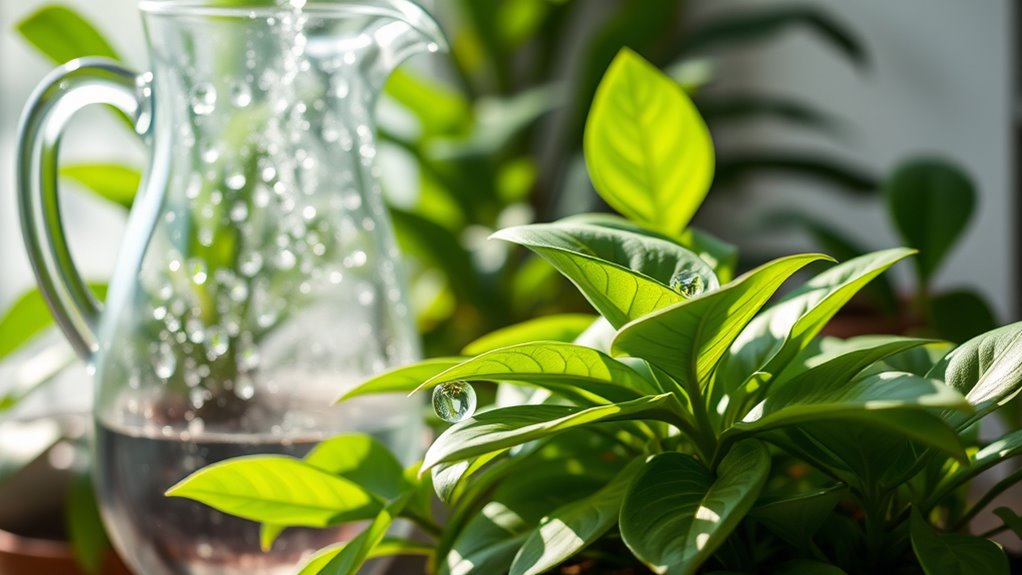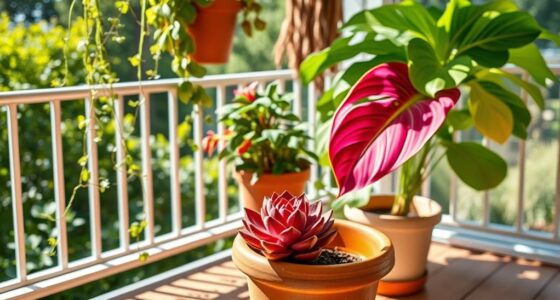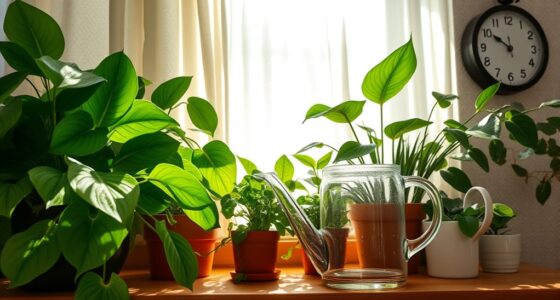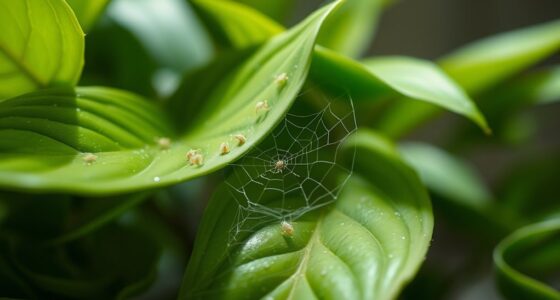Yes, rainwater is excellent for your indoor plants! It’s slightly acidic, which helps with nutrient absorption, and it’s free from chemicals like chlorine, making it safer for your plants. Rich in essential nitrates, phosphorus, and potassium, rainwater promotes healthy growth. Plus, it enhances soil health by supporting beneficial microorganisms. Collecting and storing rainwater can also save you money and protect the environment. There’s much more to discover about how rainwater can benefit your green friends!
Key Takeaways
- Rainwater has a slightly acidic pH, enhancing nutrient absorption for indoor plants.
- It is free from chlorine and fluoride, reducing the risk of leaf burn.
- Rainwater contains beneficial minerals that support robust plant growth and health.
- Using rainwater improves soil structure and promotes beneficial microbial activity.
- Collecting rainwater can lower water bills and conserve local water supplies.
Benefits of Using Rainwater for Indoor Plants

When you choose to use rainwater for your indoor plants, you tap into a resource that offers numerous benefits.
Rainwater typically has a slightly acidic pH, which is ideal for most plants, allowing them to absorb nutrients more efficiently than with tap water. Unlike tap water, rainwater lacks chlorine and fluoride, reducing the risk of leaf burn and toxicity. Additionally, rainwater is rich in beneficial minerals, which further enhances plant growth and vitality. Using rainwater can also improve nutrient availability, supporting healthy microbial activity and promoting better nutrient uptake. This natural source of water can also help provide essential nutrients that may be lacking in treated water supplies. Moreover, rainwater is free from harmful additives found in many municipal water supplies, ensuring a healthier environment for your plants.
It helps maintain balanced soil pH and supports healthy microbial activity, promoting better nutrient availability and root health. By using rainwater, you also contribute to water conservation, saving money on your bills. Plus, having a stored supply ensures you’ve got a consistent water source, even during dry spells. Rainwater truly provides a sustainable and effective option for nurturing your indoor garden.
Nutritional Value of Rainwater
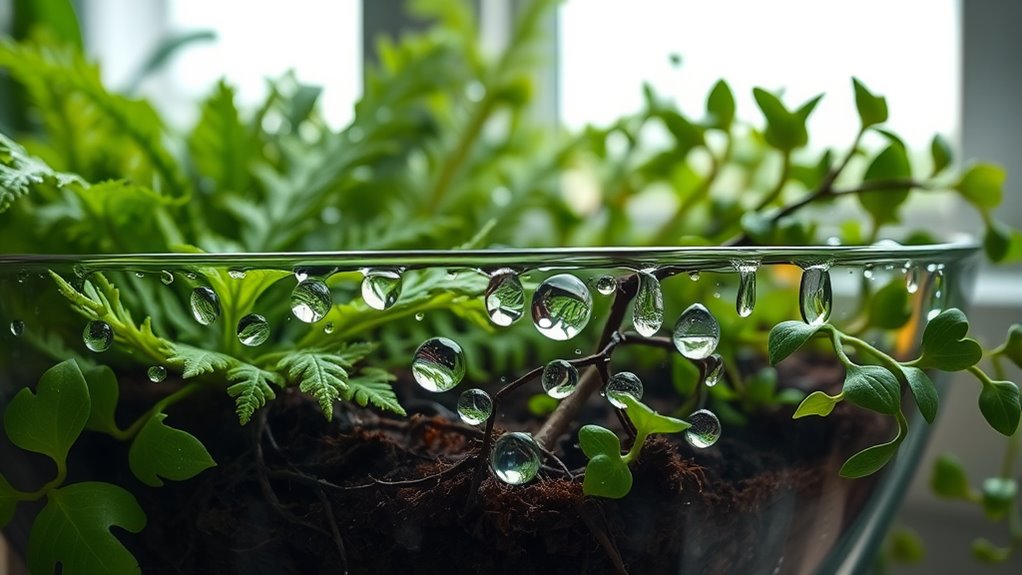
Rainwater serves as a natural nutrient source for indoor plants, offering a rich composition that supports healthy growth. It contains essential nitrates, a bio-available form of nitrogen crucial for foliage development. You’ll also find phosphorus and potassium, vital for overall plant health, alongside calcium and magnesium, which contribute to strong cellular structure. Rainwater is particularly beneficial as it contains major plant nutrients that enhance plant vitality. Additionally, using rainwater can help reduce chemical exposure that may be present in tap water. While nutrient levels can vary based on location and season, rainwater generally provides a balanced mix of nutrients. Unlike tap water, it’s free from chemicals like chlorine and has a slightly acidic pH that enhances nutrient absorption. This nutrient-rich water not only promotes robust growth but also supports soil microbial activity, ensuring your indoor plants thrive in a healthy environment. Furthermore, rainwater can help prevent pests such as aphids that may harm your plants, contributing to their overall well-being. Foraging for wild edibles in your area can also provide additional organic materials to enrich the soil for your indoor plants.
Impact of Rainwater on Soil Health
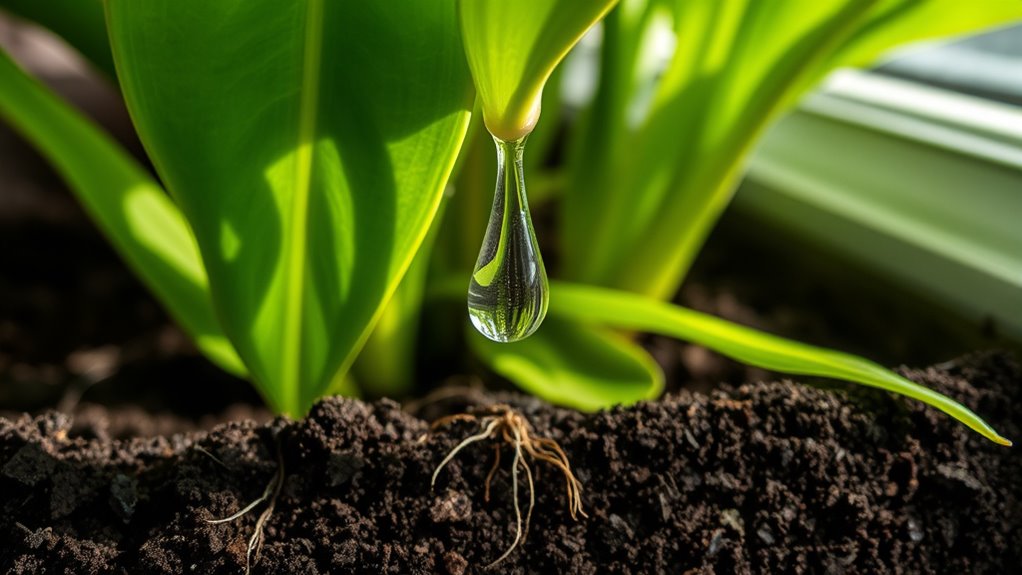
While many people focus on the immediate benefits of rainwater for plant growth, its impact on soil health is equally significant.
When rainwater penetrates the soil, it enhances water infiltration and supports the formation of stable soil aggregates, which hold nutrients and moisture better. This improved structure reduces erosion and runoff, preventing the loss of valuable topsoil. Additionally, rainwater promotes beneficial microbial populations that aid in nutrient cycling, making essential minerals more available for your plants. Moreover, the presence of beneficial microbial populations can enhance soil health over time by improving nutrient availability and soil structure. Furthermore, the enhanced soil structure can lead to increased water infiltration rates, which are crucial for maintaining moisture levels. Also, rainwater contributes to soil health by providing a more balanced pH, which can benefit plant growth. However, excessive flooding can shift microbial dynamics and strip away nutrients, leading to reduced microbial populations in the soil.
Effective Collection and Storage Methods

To effectively harness rainwater for your indoor plants, you need a reliable collection and storage system. Start with a gutter system to direct rain into barrels or tanks; this is the most common method. If you’re short on space, consider balcony or window collection using smaller containers. Ensure your setup includes first-flush diverters to keep contaminants out of your storage. Choose rain barrels made from durable materials, and don’t forget gutter protection screens to filter out debris. Regularly clean your system to maintain water quality, and use insect-proof flaps to prevent mosquito breeding. Additionally, make sure to comply with privacy considerations regarding any data collected during the setup process. Incorporating a greenhouse can further enhance your ability to extend your gardening season. A clean and organized space can also contribute to a more efficient gardening process. With these effective collection and storage methods, you can ensure your indoor plants receive clean, nutrient-rich rainwater, which is crucial for promoting environmental sustainability.
Environmental and Economic Advantages of Rainwater Use
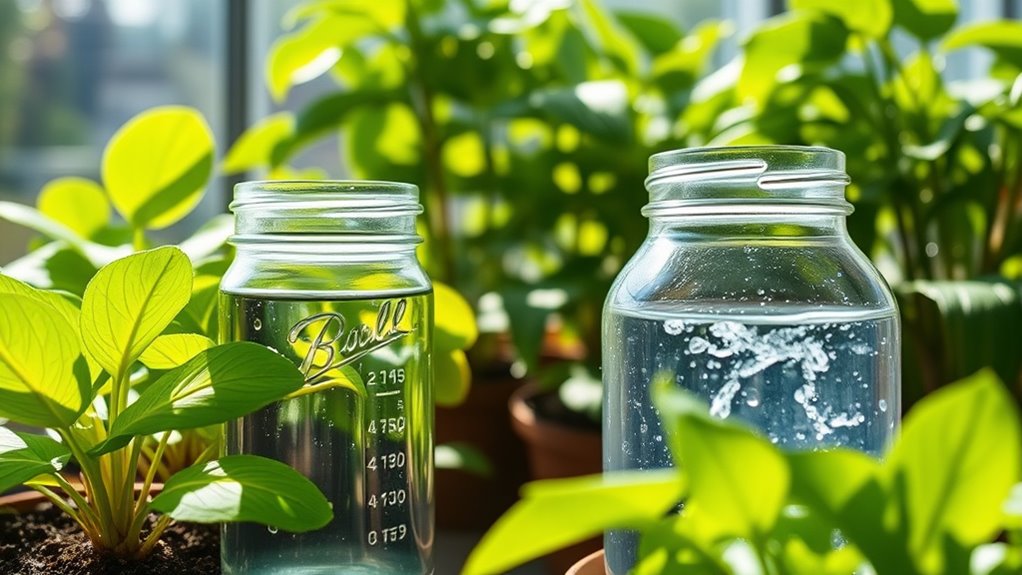
Harnessing rainwater not only benefits your indoor plants but also offers significant environmental and economic advantages.
By using rainwater, you avoid harmful chemicals like chlorine, promoting healthier soil and better plant growth. This natural resource helps maintain optimal soil health and enhances nutrient absorption, leading to vibrant plants. Moreover, rainwater is rich in all the right things, which supports quicker and greener plant growth. Additionally, using rainwater contributes to reducing greenhouse gas emissions, further supporting a healthier environment. Rainwater is also an excellent alternative to tap water, providing essential minerals that can further benefit plant health. Furthermore, utilizing rainwater can lead to improved production quantity variance, as it ensures that your plants receive the right amount of hydration consistently.
Economically, collecting rainwater reduces your water bills and provides a cost-effective way to water your plants, especially during restrictions.
Additionally, sustainable practices like rainwater harvesting conserve local water supplies and lower your carbon footprint.
With healthier plants, you might even cut down on fertilizers and maintenance costs, making rainwater use a win-win for both your wallet and the environment.
Frequently Asked Questions
Can Rainwater Cause Root Rot in Indoor Plants?
Yes, rainwater can cause root rot in indoor plants if not managed properly.
If you overwater or use poorly draining pots, excess moisture can lead to waterlogged soil.
Also, if you store rainwater incorrectly, it might become contaminated, introducing harmful pathogens.
To prevent this, always ensure good drainage and check soil moisture before watering.
How Often Should I Water With Rainwater?
Watering your plants with rainwater is like giving them a refreshing drink after a long drought.
You should water with rainwater more often during the growing season, typically from March to September.
Monitor your soil moisture by lifting the pot; if it feels light, it’s time to hydrate.
For moisture-loving plants, use rainwater frequently, but always balance it with tap water when needed to ensure your green friends stay happy and healthy.
Is Rainwater Safe for All Types of Indoor Plants?
You’ll find that rainwater isn’t universally safe for all indoor plants.
While many benefit from its chemical-free nature and balanced pH, some specialized plants may need specific conditions that rainwater can’t provide.
Sensitive species like ferns thrive on it, but you should always ensure your rainwater is collected and stored properly.
Consider filtering it if you live in urban areas to avoid potential pollutants that could harm your beloved plants.
Can I Mix Rainwater With Tap Water?
Yes, you can mix rainwater with tap water. Doing this helps dilute any chemicals in tap water, like chlorine, making it safer for your plants.
It also balances pH levels, especially if your tap water is alkaline. This combination reduces mineral buildup while still providing some essential nutrients.
Just make sure to monitor the ratio, ensuring your plants get the benefits of both water sources without any adverse effects.
Will Rainwater Affect My Plant’s Fertilizer Needs?
Absolutely, rainwater can positively impact your plant’s fertilizer needs!
By providing essential nutrients and helping maintain soil pH, it reduces reliance on fertilizers. However, it doesn’t completely replace them.
Your plants might thrive better with a balanced approach, using rainwater alongside fertilizers for optimal growth.
Conclusion
Incorporating rainwater into your indoor plant care can be a game changer. Imagine the vibrant greenery thriving from the natural nutrients rainwater provides, compared to the harsh chemicals often found in tap water. Not only does rainwater nourish your plants, but it also enriches the soil, creating a thriving ecosystem. By collecting and using rainwater, you’re not just helping your plants flourish; you’re also contributing to a sustainable future, saving money while nurturing nature’s bounty.

